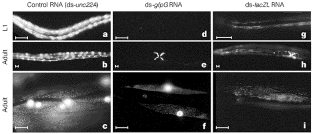Abstract
Experimental introduction of RNA into cells can be used in certain biological systems to interfere with the function of an endogenous gene1,2. Such effects have been proposed to result from a simple antisense mechanism that depends on hybridization between the injected RNA and endogenous messenger RNA transcripts. RNA interference has been used in the nematode Caenorhabditis elegans to manipulate gene expression3,4. Here we investigate the requirements for structure and delivery of the interfering RNA. To our surprise, we found that double-stranded RNA was substantially more effective at producing interference than was either strand individually. After injection into adult animals, purified single strands had at most a modest effect, whereas double-stranded mixtures caused potent and specific interference. The effects of this interference were evident in both the injected animals and their progeny. Only a few molecules of injected double-stranded RNA were required per affected cell, arguing against stochiometric interference with endogenous mRNA and suggesting that there could be a catalytic or amplification component in the interference process.
This is a preview of subscription content, access via your institution
Access options
Access to this article via ICE Institution of Civil Engineers is not available.
Subscribe to this journal
Receive 51 print issues and online access
$199.00 per year
only $3.90 per issue
Buy this article
- Purchase on SpringerLink
- Instant access to full article PDF
Prices may be subject to local taxes which are calculated during checkout



Similar content being viewed by others
References
Izant, J. & Weintraub, H. Inhibition of thymidine kinase gene expression by antisense RNA: a molecular approach to genetic analysis. Cell 36, 1007–1015 (1984).
Nellen, W. & Lichtenstein, C. What makes an mRNA anti-sense-itive? Trends Biochem. Sci. 18, 419–423 (1993).
Fire, A., Albertson, D., Harrison, S. & Moerman, D. Production of antisense RNA leads to effective and specific inhibition of gene expression in C. elegans muscle. Development 113, 503–514 (1991).
Guo, S. & Kemphues, K. par-1, a gene required for establishing polarity in C. elegans embryos, encodes a putative Ser/Thr kinase that is asymmetrically distributed. Cell 81, 611–620 (1995).
Seydoux, G. & Fire, A. Soma-germline asymmetry in the distributions of embryonic RNAs in Caenorhabditis elegans. Development 120, 2823–2834 (1994).
Ausubel, F. et al. Current Protocols in Molecular Biology (Wiley, New York, (1990)).
Brenner, S. The genetics of Caenorhabditis elegans. Genetics 77, 71–94 (1974).
Moerman, D. & Baillie, D. Genetic organization in Caenorhabditis elegans: fine structure analysis of the unc-22 gene. Genetics 91, 95–104 (1979).
Benian, G., L'Hernault, S. & Morris, M. Additional sequence complexity in the muscle gene, unc-22, and its encoded protein, twitchin, of Caenorhabiditis elegans. Genetics 134, 1097–1104 (1993).
Proud, C. PKR: a new name and new roles. Trends Biochem. Sci. 20, 241–246 (1995).
Epstein, H., Waterston, R. & Brenner, S. Amutant affecting the heavy chain of myosin in C. elegans. J. Mol. Biol. 90, 291–300 (1974).
Karn, J., Brenner, S. & Barnett, L. Protein structural domains in the C. elegans unc-54 myosin heavy chain gene are not separated by introns. Proc. Natl Acad. Sci. USA 80, 4253–4257 (1983).
Doniach, T. & Hodgkin, J. A. Asex-determining gene, fem-1, required for both male and hermaphrodite development in C. elegans. Dev. Biol. 106, 223–235 (1984).
Spence, A., Coulson, A. & Hodgkin, J. The product of fem-1, a nematode sex-determining gene, contains a motif found in cell cycle control proteins and receptors for cell–cell interactions. Cell 60, 981–990 (1990).
Krause, M., Fire, A., Harrison, S., Priess, J. & Weintraub, H. CeMyoD accumulation defines the body wall muscle cell fate during C. elegans embryogenesis. Cell 63, 907–919 (1990).
Chen, L., Krause, M., Sepanski, M. & Fire, A. The C. elegans MyoD homolog HLH-1 is essential for proper muscle function and complete morphogenesis. Development 120, 1631–1641 (1994).
Dibb, N. J., Maruyama, I. N., Krause, M.(Author: OK?) & Karn, J. Sequence analysis of the complete Caenorhabditis elegans myosin heavy chain gene family. J. Mol. Biol. 205, 603–613 (1989).
Sulston, J., Schierenberg, E., White, J. & Thomson, J. The embryonic cell lineage of the nematode Caenorhabditis elegans. Dev. Biol. 100, 64–119 (1983).
Sulston, J. & Horvitz, H. Postembyonic cell lineages of the nematode Caenorhabiditis elegans. Dev. Biol. 82, 41–55 (1977).
Draper, B. W., Mello, C. C., Bowerman, B., Hardin, J. & Priess, J. R. MEX-3 is a KH ___domain protein that regulates blastomere identity in early C. elegans embryos. Cell 87, 205–216 (1996).
Sulston, J. et al. The C. elegans genome sequencing project: a beginning. Nature 356, 37–41 (1992).
Matzke, M. & Matzke, A. How and why do plants inactivate homologous (trans) genes? Plant Physiol. 107, 679–685 (1995).
Ratcliff, F., Harrison, B. & Baulcombe, D. Asimilarity between viral defense and gene silencing in plants. Science 276, 1558–1560 (1997).
Latham, K. Xchromosome imprinting and inactivation in the early mammalian embryo. Trends Genet. 12, 134–138 (1996).
Chalfie, M., Tu, Y., Euskirchen, G., Ward, W. & Prasher, D. Green fluorescent protein as a marker for gene expression. Science 263, 802–805 (1994).
Clark, D., Suleman, D., Beckenbach, K., Gilchrist, E. & Baillie, D. Molecular cloning and characterization of the dpy-20 gene of C. elegans. Mol. Gen. Genet. 247, 367–378 (1995).
Mello, C. & Fire, A. DNA transformation. Methods Cell Biol. 48, 451–482 (1995).
Acknowledgements
We thank A. Grishok, B. Harfe, M. Hsu, B. Kelly, J. Hsieh, M. Krause, M. Park, W. Sharrock, T. Shin, M. Soto and H. Tabara for discussion. This work was supported by the NIGMS (A.F.) and the NICHD (C.M.), and by fellowship and career awards from the NICHD (M.K.M.), NIGMS (S.K.), PEW charitable trust (C.M.), American Cancer Society (C.M.), and March of Dimes (C.M.).
Author information
Authors and Affiliations
Corresponding author
Supplementary Information
Rights and permissions
About this article
Cite this article
Fire, A., Xu, S., Montgomery, M. et al. Potent and specific genetic interference by double-stranded RNA in Caenorhabditis elegans. Nature 391, 806–811 (1998). https://doi.org/10.1038/35888
Received:
Accepted:
Issue Date:
DOI: https://doi.org/10.1038/35888


